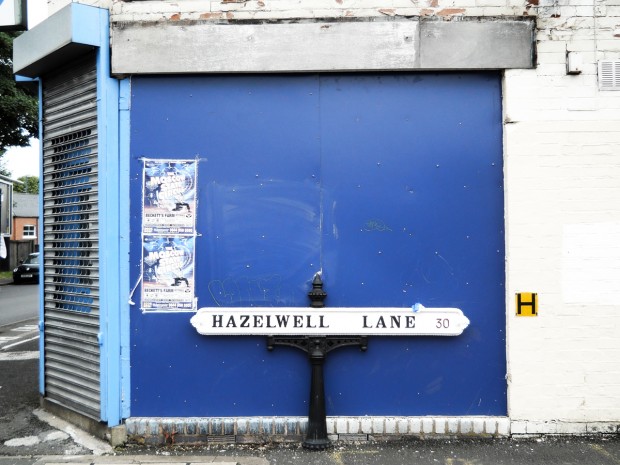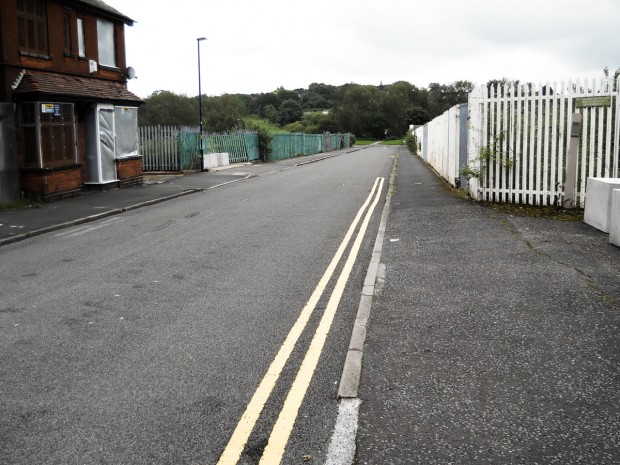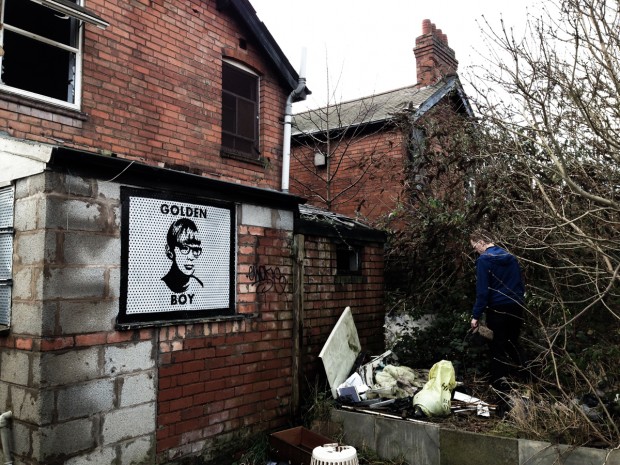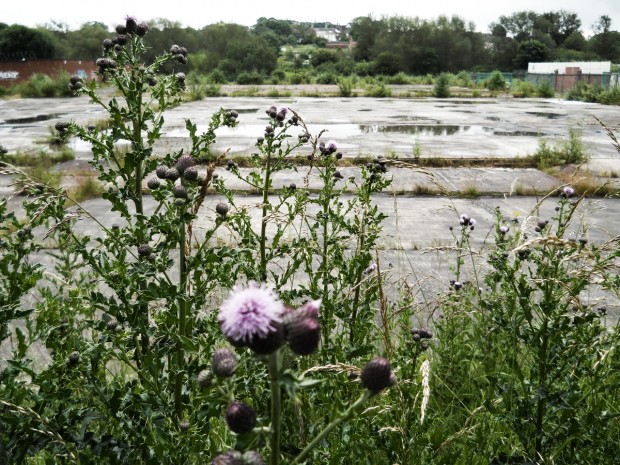You have no items in your cart. Want to get some nice things?
Go shopping
I have three routes in. Often, I catch a bus down to the high street. The 45 and 47 take you via arterial roads, over the bridge that spans the canal, past Wickes and Magnet. Warehouses give way to cash-and-carrys, takeaways and junk shops. People from all over the city come here on very specific errands. Grab a second-hand vacuum part and get out. On foot I tend to circumvent all that by walking the canalside towpath: an arc of graffiti. The chalk path ends by a pub popular with bikers. They drink and play pool in an upstairs room that is draped with nationalist paraphernalia. Sometimes I approach from a completely different direction, down past the train station, measuring the waning of Bourneville’s Quaker influence, which eventually bleeds out on the doorstep of a pub, the British Oak. This pub is a Grade II listed building and there are no bikers. Beyond it is my destination.
Quakers and Cadbury World to the west, canalside and bikers unwinding to the south. I wander. I browse Stagg and Columbus guitars stacked alongside mobility equipment in a shop called Pandora’s Box. Greetings of ‘Yes Boss?’ sound from within the takeaways. The menus are stocked full of parentheses. I once spoke with Jehovah’s Witnesses living a quiet and happy life in the houses behind the school. I stop for a coke, then circle a high-walled reclamation yard. Once, I found a blank poster duct-taped to the redbrick wall of the 1920s Electric Supply building. The text and pictures had faded except for some smudged ink that had a rainbow effect in certain light. It had been a poster for a missing pet before rainwater effaced it.
Three years ago I was told about Hazelwell lane. I was at an art workshop in a pop-up café on Stirchley’s high street. I was in the early stages of planning a trip to Detroit. A photographer, who heard me talking about the Motor City’s abandoned housing, told me there was a ruined street in Stirchley: Hazelwell lane, a row of terraced houses waiting for demolition. He said it was in the middle of a site that Tesco had bought for development. The development had hit on problems and the last resident of the lane had not yet moved out.
Eventually I moved to the area. I got a flat in the annex of my Bangladeshi landlady’s house. Her husband wasn’t well and I passed him, watching TV, every day as I entered the flat through the garden gate. There was a gouge in the wood of the front door. I convinced myself it was an axe-slash. I started making daily visits to Hazelwell Lane. I broke up long days of study with frequent walks. When I went jogging down the tiny river I always made sure to come back via Hazelwell lane. I liked to reach it when I was panting and knackered, dying for a Lucozade. Mid-morning and early evening were the best hours to visit, when crows were ambling about at the bottom of the deserted road.
Hazelwell lane was the area’s invisible, unsignposted centre. Fourteen houses remained. Every house but one was barricaded against squatters, the doors and windows blocked off with pockmarked steel. The terraces made up a partially broken line, encroached upon by swathes of brownfield. This meant that, walking from the traffic-heavy high street, you could quickly slip into a scene of dried-out buddleia and the split concrete of old car parks.
In an alleyway between houses, a host of nettles choked off a scrappy patch of grass. In the summer, blackberries swung gently back and forth in the upper reaches. When I went with a friend to take photographs, we ate some of the blackberries. We learned that it was best to pluck them and wait a few seconds, to see the tiny grubs and insects crawling out from the pulps. We blew them off and ate the berries anyway, wincing.
It was around that time that we posted a card through one of the doors of Hazelwell Lane.
This house was special, knitted in with the others but spiritually separate. The windows, free of grills, were clean and neatly netted. The only trace of steel was the clunky letterbox – the only one left on the entire lane. And whereas the other houses were gagged and bound, ready for demolition, this one was still someone’s home.

We posted a supportive card. We told the owner to keep fighting. It probably went straight in the bin, along with all the letters from the council imploring him to leave. Given his evident dedication to staying, I wouldn’t have been surprised to find that he’d placed his bin right beneath the letterbox, to funnel away any external commentary. But I could only speculate – we never saw or heard from him. He wasn’t mentioned in news reports.
I last visited Hazelwell lane in January. It was a watershed moment. Until that point the street had been in stasis, a string of empty homes and a hold-out. This time, on the last resident’s door, there was this: All metals are removed from this property. His house had been boarded up.
I went around the back to check the scatterings of the garden. There was a stencilled graffiti image of a boy’s face with the tagline Golden Boy. There was a large crescent of broken brick, a shamanistic protection. On top of of a pile of objects taken from on of the houses there was a framed photo of the Jamaican football team. It was from the World Cup, France ’98. This was the first Jamaica team to qualify. Marcus Gayle, Ricardo Gardner and Robbie Earle loomed large. Two of them once played for Wimbledon.
I wish I had taken the team photo and I don’t know why I didn’t. France ’98 was the second football tournament I emotionally invested in. Owen’s sprint and finish eclipsed Gazza’s touch and volley against Scotland, two years earlier. I don’t tend to get so sucked in now. I go back to France ’98 if I want pain. Jamaica didn’t get out of the group stages but they managed to finish with a win, 1-0 against Japan. Had this team photo belonged to the last resident of Hazelwell lane? It was a small mystery, but not one to spend any time on. The Golden Boy graffiti seemed like a swipe at something large and inescapable. The boy had thick-rimmed glasses and a bowl cut. The street was now uninhabited.

Charlie Wright is a retiree, living on the River Streets estate near the Birkenhead docks. He lives alone. Six hundred houses were demolished and cleared in preparation for a police command centre but, as Paul Gallagher recently reported in The Independent , Charlie Wright refused to move. He lost every neighbour he had. Pressure from the council did not move him. In the end, the police command centre never materialised. The River Streets estate was built to house shipbuilders and factory hands. Charlie now lives in the last existing house. Until a privately funded regeneration project materialises – one likely dependent on foreign investment – this will remain the case.
Anna Minton relays similar cases in Ground Control: Fear and Happiness in the Twenty-First-Century City (2009). She visits Garnet Street in Oldham, Edge Lane in Kensington and the famous ‘Welsh Streets’ in Liverpool. These streets are mostly rows of boarded-up Victorian housing. They are still home to a few defiant residents, loyal to their long-owned homes. Minton meets the Elizabeths, Joans and Kathleens who form action groups or take on the ‘battleaxe mantle’ against local councils and developers. These are the people who come to mind when I walk down Hazelwell lane, wondering about the last owner on that abandoned street. I think also of the semi-mythical Ken Wild, the farmer who supposedly defied the bulldozers during construction of the M62 with the result that the road now splits at his property (although, whatever the farmer’s motives it now seems the road had to take that course anyway due to a geological fault).
Pixar’s 2009 blockbuster Up took its central premise from that familiar motif of the last house in the face of development. The homeowner, Mr Fredricksen, is a cantankerous widower who refuses to give in to pressure from developers and builders. He acrimoniously blows dust off his mailbox with a leafblower. A giant building site dwarfs his two-storey marital home, which is painted in pastel blues, yellows and pinks. Contrast these soft-focus colours with the black suit and white hard hat of the businessman who is trying to oust him. The ‘boss’ makes phone calls in the background while his henchmen (patronising but friendly builders) placate Mr Fredricksen and try to get him to sell up.
The curious thing about Up is the way it seems to desert the familiar narrative. Fredricksen uses helium balloons to take to the air in his house and escapes the development to find Paradise Falls in South America. The idea of holding out against the developers is abandoned. Instead, Fredricksen sets out to fulfil a childhood promise to his deceased wife. They had dreamed about finding Paradise Falls and living there, having both idolised the adventurer and explorer Charles Muntz. The film’s central conceit is that Muntz turns out to still be alive, still hunting near Paradise Falls, and the years haven’t caught up with him as we might have expected.
Forget property developers; it’s Muntz who is the film’s bad guy. Fredricksen finds his idol jaded, bitter and vengeful, an Ahab seeking not the whale but a species of large, rare bird that has evaded capture for years. Muntz is not the man Fredricksen thinks he is. He is so determined to capture the bird and convince people he isn’t a fraud that he terrorises Fredricksen. The canker at the heart of the film, more destructive than the developers or Muntz, is the irrepressible pursuit of the ‘authentic’. Muntz needs to prove the existence of the rare bird but his violent and single-minded pursuit of the “genuine article” is delusion. Fredericksen is forced to conclude that his childhood hero was never what he purported to be.
This all sits uncomfortably with the opening motif: homeowner versus developer. Perhaps, through the course of the film, we are led to view the ‘authenticity’ of Fredricksen’s house, of the area before it became a building site, of suburbs prior to redevelopment, to be as dubious as Charles Muntz. The question then is whether the film acts as an apologist for the oft-nefarious actions of urban developers. At times I think not; Up is a cautionary tale about fetishising the past, glorifying adults, pursuing (and renegotiating) dreams. Fredricksen needs to move on but keep the spirit of adventure alive. The question is whether he can do so on his own terms.
For my own part, I worry. Am I fetishising the abandoned houses of Hazelwell Lane? I’ve noticed the term ‘ruin porn’ has become prominent in the discussion of urban exploration. I eventually visited Detroit in 2011. The Motor City is synonymous with urban exploration: the vivid photos of Yves Marchand and Romain Meffre capture the ruined caverns of municipal lobbies and atriums in a startling way. A few minutes of browsing these images can leave the impression that the apocalypse we feverishly imagine in popular film and art is upon us. But it isn’t.
Much has been made of ruin porn, of the divisions between urban explorers and photographers; of the aesthetic and historic precedents for our obsession with decay. My own problem is the decontextualised nature of these photos. Fetishisation comes from framing urban ruins in isolation. The truth of urban ruin is that life goes on, often nearby. This is true of Hazelwell lane, which is only partially hidden from the busy high street nearby. Even in Detroit, where the scale of ruination is almost overwhelming, the only wonder I truly felt was that people were still living there. At half past three, between photographingthe Grand Trunk station and some abandoned housing complete with graffiti mural, we saw children waiting at bus stops. They were on their way home from school. These children would make a brutally honest (dare I say, authentic) foreground to photographs of the Motor City, but they never feature.

By the end of Up, Fredricksen has embraced life again. He lives on Muntz’s airship, called The Spirit of Adventure, and adopts Russell, a young boy scout, as his son. He has come to terms with life after the death of his wife. He is happier for it. The certainties of marriage, a house and adulthood have given way to the fluidities of adoption, a roving airship and rediscovered freedoms. If the uncompromising pursuit of authenticity is the film’s troubled heart, what can we make of the developers who, in fact, gave Fredricksen the impetus to move on and put his obsessions behind him? I’m undecided. I love the film but can’t help thinking it explores some troublesome ideological territory.
Life beside ruins is a curious existence. For all my fascination with the solitude, with the sense of being at the end of a continuum, I often remind myself that I was drawn to Hazelwell lane because there was life there. I went to see the last resident, or at least the signs of him. Likewise, I was drawn to Stirchley because of the variety of life (even as the independent traders were dwindling and the brownfield sites growing). The area I know may disappear. It constantly threatens to. There is a tension, an excitement even, in this threat. Spirit of Adventure isn’t quite the right name for it. It’s the Spirit of Misadventure that brings me back again and again. I watch for change. And a giant supermarket will certainly bring change. I don’t want to stop at tracking these changes; rather, I’ve started to entertain a wild fantasy, a selfish one. If I’m there often enough, maybe they will build around me. On my terms. There’s a thought.

About Chris Prendergast
Chris Prendergast was born in Birmingham in 1987. He has an MA in Creative Writing from Keele University. In 2009 he won the Charles Swann award for his dissertation on David Berman’s Actual Air. He has taught creative writing at various levels and is currently writing his doctoral thesis on the post-industrial status of Birmingham.



